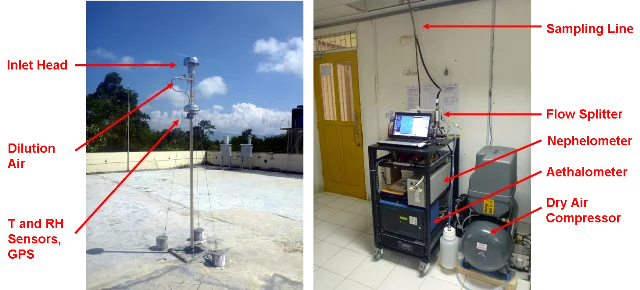
The importance of measuring aerosol optical properties
Aerosols influence the atmospheric energy budget through direct and indirect effects:
Therefore, knowledge of aerosol radiative properties is needed for the evaluation of aerosol effects on climate and visibility. The fundamental quantity of interest for these applications is the aerosol light extinction coefficient (σep). σep is the sum of the light scattering (σsp) and light absorption (σap) coefficients. Another important parameter is the aerosol single-scattering albedo, defined as σsp/σep. It describes the relative contributions of scattering and absorption to the total light extinction. Purely scattering aerosols (e.g. ammonium sulfate or sodium chloride) have values of 1, while very strong absorbers (e.g. soot or black carbon) have values of around 0.3. An analysis of the wavelength dependence of all these parameters allows deriving further information on the aerosol type. For example, biomass burning aerosols or mineral dust are characterized by very distinct different optical properties compared to the background aerosol.
Within the CATCOS project, the aerosol light scattering coefficient, σsp, is measured with a multi-wavelength integrating nephelometer (Ecotech Inc., Model Aurora 3000). This instrument operates at 3 wavelengths and is able to measure total scattering and hemispheric backscattering. The light absorption coefficient (σap) is measured with a multi-wavelength aethalometer (Magee Scientific Inc., Model AE31).
We also perform the same type of measurements at the GAW Global Station Jungfraujoch (Switzerland)
- Direct radiative effects include the scattering and absorption of solar radiation and the subsequent influence on planetary albedo and the climate system.
- Indirect effects involve the influence of the aerosol on cloud properties, cloud lifetime and cloud cover through acting as cloud condensation nuclei (CCN) and ice nuclei (IN). Anthropogenic changes of the atmospheric aerosol loadings are expected to cause an overall negative climate forcing partially offsetting the positive forcing by greenhouse gases.
Therefore, knowledge of aerosol radiative properties is needed for the evaluation of aerosol effects on climate and visibility. The fundamental quantity of interest for these applications is the aerosol light extinction coefficient (σep). σep is the sum of the light scattering (σsp) and light absorption (σap) coefficients. Another important parameter is the aerosol single-scattering albedo, defined as σsp/σep. It describes the relative contributions of scattering and absorption to the total light extinction. Purely scattering aerosols (e.g. ammonium sulfate or sodium chloride) have values of 1, while very strong absorbers (e.g. soot or black carbon) have values of around 0.3. An analysis of the wavelength dependence of all these parameters allows deriving further information on the aerosol type. For example, biomass burning aerosols or mineral dust are characterized by very distinct different optical properties compared to the background aerosol.
Within the CATCOS project, the aerosol light scattering coefficient, σsp, is measured with a multi-wavelength integrating nephelometer (Ecotech Inc., Model Aurora 3000). This instrument operates at 3 wavelengths and is able to measure total scattering and hemispheric backscattering. The light absorption coefficient (σap) is measured with a multi-wavelength aethalometer (Magee Scientific Inc., Model AE31).
We also perform the same type of measurements at the GAW Global Station Jungfraujoch (Switzerland)
CATCOS aerosol instrumentation
Aethalometer
The aerosol light scattering coefficient, σap, is measured with a multi-wavelength aethalometer (Magee Scientific Inc., Model AE31). This instrument is capable of measuring aerosol light absorption with a high time-resolution at seven wavelengths, from 370 nm (UV) to 950 nm (IR). The measurement principle is based on the rate of change of transmission through a fibre filter as particles are deposited on the filter. Calibration of these filter-based methods is complex and is required because the relationship between change in light transmission and aerosol absorption optical depth on the filter depends on many factors, including the particular filter medium and the light-scattering nature of the particles. Recent publications have presented successful approaches for this calibration, which require simultaneous nephelometer measurements to correct for substantial effects of light scattering by the particles on the filter. As the aethalometer models perform the filter change automatically, routine maintenance checks are typically minimal.
More
More
Nephelometer
The aerosol light scattering coefficient, σsp, is measured with a multi-wavelength integrating nephelometer (Ecotech Inc., Model Aurora 3000). This instrument operates at wavelengths of 525nm (green), 450nm (blue) and 635nm (red), and has the added feature of being able to measure σsp over two angular ranges: total scattering (9-170° degrees) and hemispheric backscattering (90-170°, denoted as σbsp). The high sensitivity, multiple wavelengths, and backscatter capability of this instrument makes it suitable for monitoring aerosol light scattering properties in support of radiative climate studies. Calibration is achieved by filling the instrument with a particle-free gas that has a known scattering coefficient. Filtered, ambient air is used as the downscale calibration point, and CO2 as the upscale point. Generally, calibrations with filtered air are performed automatically every few hours. Manual calibrations with CO2 should be done typically every 1-3 months.
Sampling system
An omni-directional high efficiency dedicated air inlet has been designed for aerosol sampling (cover to exclude precipitation, vertical stack, laminar sampling flow, high aerosol transmission efficiency, conductive and non-corrosive tubing material, etc) such that an undisturbed aerosol is delivered to the aerosol instruments. At locations with high ambient relative humidity, the sampling air is diluted with particle-free dry air, to guarantee a relative humidity of less than 40% in the instruments as it is recommended by GAW.
